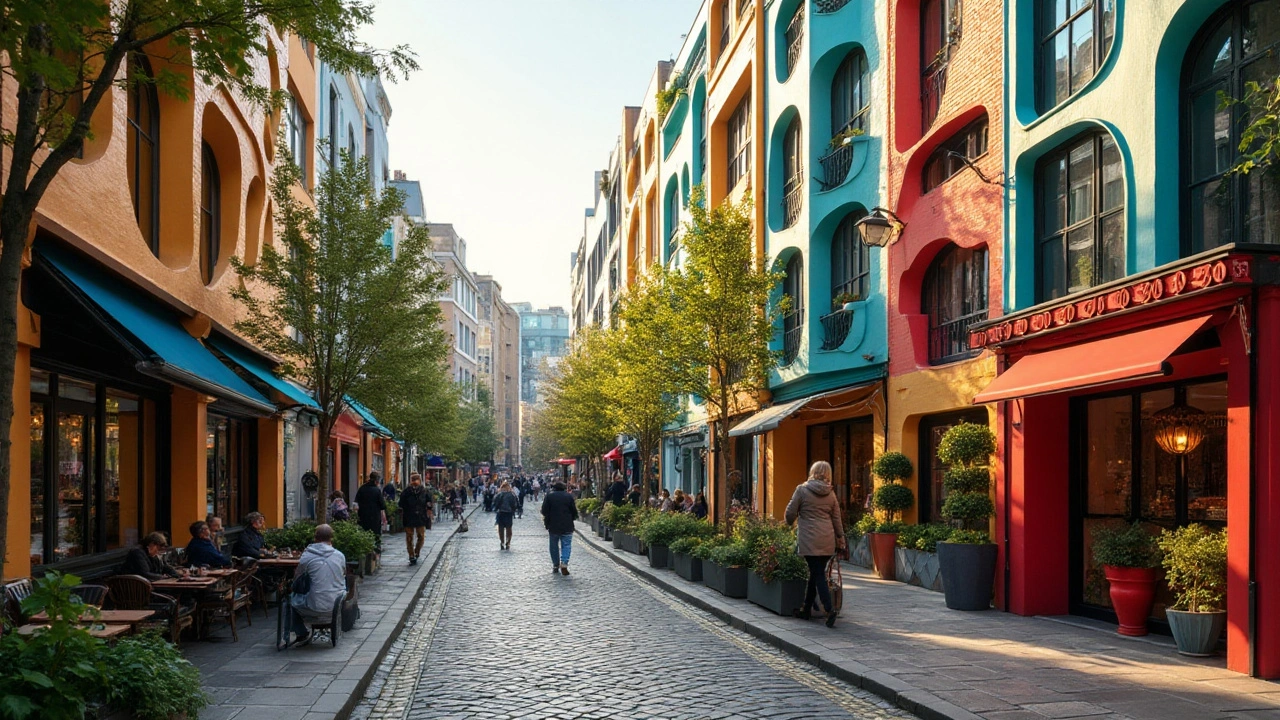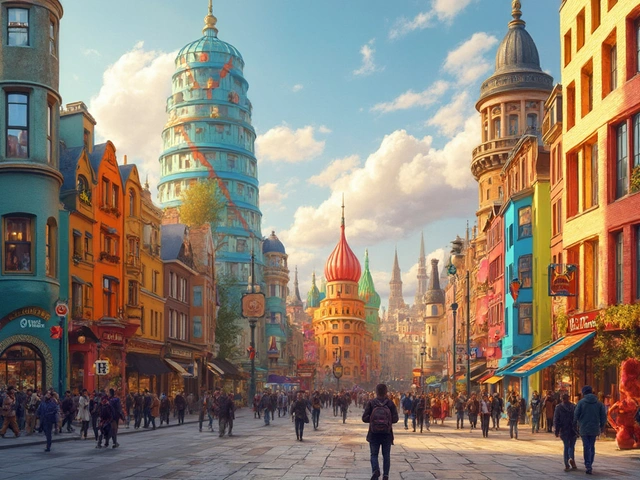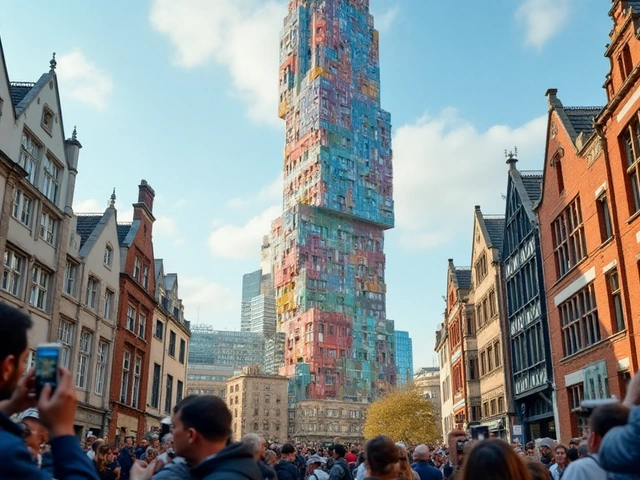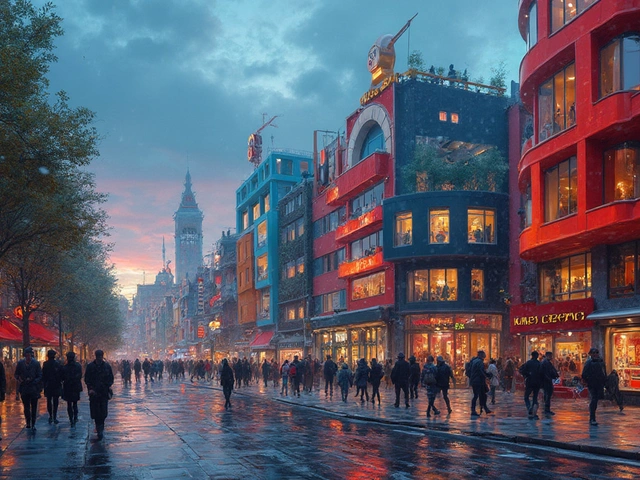Postmodern architecture has a charmingly quirky side compared to the minimalist styles of modern architecture. Emerging in the mid-20th century, this eclectic style shook things up with its bold use of colors, materials, and historical references.
These daring designs have not only altered the aesthetics but also redefined urban landscapes. Today, cities around the world, from New York to Melbourne, flaunt these imaginative structures that break away from conventional forms.
In this article, we will explore what postmodern architecture entails, how it has shaped today’s cities, and why it continues to captivate architects and city dwellers alike. Whether you’re an urban enthusiast or just curious about those unusual buildings in your neighborhood, there’s a lot to appreciate and discover about postmodern architecture.
- Understanding Postmodern Architecture
- Key Characteristics of Postmodern Buildings
- Impact on City Planning
- Postmodern Architecture in Community Spaces
- Tips for Appreciating Postmodern Architecture
Understanding Postmodern Architecture
Postmodern architecture emerged as a critical response to modernism, which often focused on minimalism and the principle of 'form follows function.' In contrast, postmodern architects embraced complexity and contradiction, blending various styles and influences to create buildings that made bold statements. This movement began in the late 1960s and gained momentum throughout the 1970s and 1980s, challenging the austere and functional designs that had dominated architecture for much of the 20th century.
One of the most distinctive aspects of postmodern architecture is its playful and eclectic use of historical references and ornamentation. Architects like Robert Venturi and Michael Graves sought to reintroduce elements from classical architecture, using columns, arches, and pediments in a new and often ironic context. Venturi famously noted, 'Less is a bore,' a direct challenge to the modernist mantra of 'less is more.'
Postmodern buildings frequently feature a mix of materials, colors, and textures that create a sense of richness and diversity. This approach not only contrasts with modernist uniformity but also aims to make architecture more accessible and engaging to the public. By incorporating familiar and sometimes whimsical elements, postmodern architecture invites viewers to interpret and enjoy buildings on multiple levels.
An essential aspect of postmodernism is its emphasis on local contexts and cultural specificity. Architects often designed buildings to reflect their surroundings and resonate with local histories and traditions. This sensitivity to context can be seen in projects like the Piazza d'Italia in New Orleans, designed by Charles Moore, which celebrates the city's Italian-American heritage through a playful and colorful reinterpretation of classical forms.
The impact of postmodern architecture extends beyond aesthetics, influencing urban planning and the social fabric of cities. By focusing on diversity and complexity, postmodernism encourages variety in urban environments, promoting mixed-use developments and pedestrian-friendly spaces. This approach aligns well with contemporary sustainable design practices, which emphasize the importance of creating vibrant, livable communities.
Postmodern architecture continues to be a subject of debate and fascination within the architectural community. While some critics argue that its eclectic and often contradictory nature can lead to a sense of chaos and superficiality, others appreciate its embrace of complexity and celebration of the human experience. As with any artistic movement, postmodernism's true legacy lies in its ability to provoke thought and inspire creativity.
Architect Philip Johnson once remarked, 'Postmodernism is not a style, but a cultural phenomenon reflecting broader societal shifts.'
Understanding postmodern architecture requires an appreciation of its historical context and an openness to its seemingly contradictory elements. By challenging conventions and celebrating complexity, postmodern architecture offers a refreshing and thought-provoking perspective on the built environment. As you explore cities with postmodern buildings, take the time to notice the playful details, the rich variety of forms, and the stories that these structures tell.
Key Characteristics of Postmodern Buildings
When you think of postmodern architecture, a few striking images might come to mind. Bold colors, unusual shapes, and a mix of old and new elements are all hallmarks of this eclectic style. One of the standout features of postmodern buildings is their departure from the minimalist ethos of modernism. Instead of sleek, glass-covered boxes, postmodern architecture revels in whimsy and variety.
Postmodern buildings often incorporate historical references in creative ways. For instance, you'll find columns, arches, and even decorative facades that harken back to classic architectural styles but with a twist. Architect Robert Venturi famously quipped, "Less is a bore," capturing the playful spirit of this movement. This approach encourages a sense of fun and creativity, making buildings more engaging and less austere.
Another fascinating trait is the use of diverse materials. In postmodern designs, it's common to see an interplay of glass, metal, and traditional materials like brick and stone in a single structure. This variety adds texture and depth, making buildings visually interesting from multiple angles. Take, for instance, the Portland Building in Oregon, designed by Michael Graves. This building uses colorful tiles, reflective surfaces, and classical motifs to create a vibrant, eye-catching facade.
The play with forms is another captivating aspect. Postmodern architecture often features asymmetrical designs, playful angles, and unexpected shapes. This breaks the rigidity of modernist principles and introduces a sense of movement and dynamism to urban landscapes. Frank Gehry’s Guggenheim Museum in Bilbao is a quintessential example. Its swirling curves and unconventional form have turned it into a modern-day architectural marvel.
Interestingly, postmodern architecture also emphasizes the context. Designers take into account the surroundings and culture when creating buildings. This mindful approach can be seen in the work of Charles Moore, whose Piazza d'Italia in New Orleans references both Italian Renaissance architecture and local Creole culture. It creates a space that feels rooted in its environment while still being forward-thinking.
The use of ornamentation is another key characteristic. Unlike the minimalist approach that eschews decoration, postmodern architecture embraces it. Buildings often feature playful embellishments, sculptures, and murals that add character and narrative. For instance, the AT&T Building in New York, designed by Philip Johnson, boasts a 'Chippendale' top – an ornamental feature resembling antique cabinets, adding a whimsical touch to the skyscraper.
To sum it up, postmodern architecture stands out for its colorful, diverse, and eclectic nature. By mixing styles, materials, and forms, it brings a breath of fresh air into urban settings. This approach not only redefines how cities look but also how people interact with them, making spaces more inviting and stimulating.

Impact on City Planning
When it comes to reshaping urban spaces, postmodern architecture has had a remarkable influence on city planning. Postmodernism introduced flexibility and creativity in a field once dominated by rigid, uniform designs. City planners began to embrace diverse architectural styles to reflect the cultural and social intricacies of urban life. This shift was particularly evident in the 1980s, a decade renowned for architectural experimentation and innovation.
A significant facet of this influence is the way postmodern designs encouraged mixed-use developments. Instead of segregating residential, commercial, and recreational areas, architects began to blend these spaces, creating vibrant and multifaceted urban environments. This approach not only maximized land use but also fostered a sense of community, making cities livelier and more engaging.
One notable example can be seen in La Défense, Paris. This district is famous for its towering skyscrapers and modernist designs, but recent postmodern additions have added new dimensions to its skyline. The integration has turned La Défense into a melting pot of past and contemporary designs, illustrating how postmodern architecture can seamlessly coexist with its predecessors.
Such breakthroughs also brought about significant changes in pedestrian spaces. Architects and planners began to focus on human-scale urban design, ensuring public areas were accessible and welcoming. Jane Jacobs, a prominent urbanist, emphasized this by saying, "Cities have the capability of providing something for everybody, only because, and only when, they are created by everybody." Her insights propelled the development of inclusive spaces that cater to diverse groups of people.
"The only way to deal with an unfree world is to become so absolutely free that your very existence is an act of rebellion." — Albert Camus
Moreover, postmodern architecture has played a crucial role in preserving historical structures. Instead of demolishing old buildings, many postmodern projects integrate these structures to celebrate the past while introducing contemporary elements. This approach, often termed as 'adaptive reuse,' is not only sustainable but also helps in maintaining the cultural heritage of a city. An excellent example is the Tate Modern in London, which repurposed an old power station into an art museum while retaining its historical essence.
Another way postmodern design has influenced city planning is by challenging conventional aesthetics. Gone are the days when uniformity and simplicity dominated urban landscapes. Postmodernism brought flamboyance and eclecticism, encouraging architects to play with forms, colors, and materials. Cities like Barcelona and Tokyo are perfect examples of this, where you'll find a mix of whimsical and avant-garde buildings that contribute to their unique identities.
There’s no doubt that postmodern architecture has left a lasting imprint on modern cities. Its principles have become integral to creating dynamic and inclusive urban environments that cater to the needs of all residents. This architectural movement continues to inspire and redefine the way we think about city planning, proving that creativity and diversity are key to shaping our urban futures.
Postmodern Architecture in Community Spaces
When we think about community spaces, we often picture places where people gather, relax, and connect. Postmodern architecture plays a significant role in transforming these spaces into vibrant, inclusive environments. It often challenges the sterile, homogeneous designs of modernism by injecting whimsical, human-centric elements.
Take the famous Piazza d'Italia in New Orleans, a prime example of postmodernism by architect Charles Moore. This public square incorporates playful classical references and innovative use of water features. It's not merely functional; it also delights and surprises visitors. Such spaces become landmarks, encouraging community interaction and cultural engagement.
In addition to public squares, postmodern architecture flourishes in libraries, museums, and theaters. These buildings often serve as cultural hubs, blending old and new, high art and pop culture. The Centre Pompidou in Paris, for example, is a postmodern marvel that houses an extensive public library, a museum of modern art, and a center for music and acoustic research. Its exposed structural system and color-coded mechanical services make it instantly recognizable and a beloved community space.
Postmodern design encourages public participation by breaking down barriers between indoor and outdoor spaces. Architect Michael Graves applied this philosophy in the design of the Portland Building, using multicolored facades and ornamental flourish to create a visually engaging public office building. These features invite people to explore and inhabit spaces more freely, fostering a sense of belonging.
Moreover, postmodern architecture often incorporates local cultural elements, reflecting the community's identity. The Swan Bells in Perth, Western Australia, blends contemporary design with historical references to the city’s maritime and musical traditions. This approach not only preserves local heritage but also makes the architecture accessible and relatable to the public.
Postmodern architecture is also celebrated for its adaptability. As urban areas continue to grow and diversify, these community spaces can easily undergo modifications without losing their character. This flexibility is vital in enhancing urban resilience and meeting changing community needs.
Beyond aesthetics, postmodern community spaces emphasize functionality and inclusivity. Architect Denise Scott Brown advocates for designs that consider various social dynamics, ensuring that spaces are affordable and accessible to everyone. Her work at the Sainsbury Wing of the National Gallery in London offers a thoughtful integration of public needs, from visitor flow to enhanced accessibility.
In a world increasingly focused on creating sustainable and livable cities, postmodern architecture provides valuable insights. Its principles of adaptability, inclusivity, and local cultural integration make it an enduring influence on urban planning and development. As we look toward the future, integrating these postmodern elements can help us develop community spaces that are not only functional but also rich in character and cultural significance.

Tips for Appreciating Postmodern Architecture
Falling in love with postmodern architecture is like getting to know an old friend with some unique habits. You start by admiring their quirks, then slowly come to understand the deeper meaning behind their style. Let’s dig into some practical tips that will help you appreciate these fascinating structures more deeply.
Firstly, take a moment to notice the vibrant colors and bold shapes that are often characteristic of postmodern designs. Unlike their modernist counterparts, which typically favor sleek and austere aesthetics, postmodern buildings celebrate color and intricate detailing. For instance, the AT&T Building in New York, designed by Philip Johnson, is a perfect example. With its 'Chippendale' top resembling a piece of furniture, this building exemplifies postmodernism's playful approach to architectural form.
Second, look for historical references incorporated into the design. Postmodern architects often drew inspiration from a plethora of styles and periods. It’s not uncommon to see ancient Greek columns blended with modern glass facades. Michael Graves’ Portland Building is a great example of this eclectic approach. It includes classical elements like a keystone and pilasters combined with a modern grid-like structure.
Understanding the context and the architect's vision can enhance your appreciation as well. Robert Venturi, one of the pioneers of postmodern architecture, famously stated, "Less is a bore." His sentiment reflects the movement’s philosophy of incorporating complexity and contradiction into architecture. This approach makes buildings not only stand out but also provoke thought and conversation.
Another tip is to explore the role these buildings play in their urban settings. Postmodern architecture is known for its adaptability to the existing environment. These structures often create a dialogue with their surroundings instead of standing apart. The Piazza d’Italia in New Orleans, designed by Charles Moore, is an excellent case. This urban public plaza combines elements of Italian history with local cultural references, making it a beloved space for community gatherings.
Additionally, consider the social aspects postmodern architecture brings to urban spaces. These buildings often emphasize user experience and interaction. Unlike modernist structures which can sometimes feel cold and impersonal, postmodern buildings invite engagement. The Swan and Dolphin Hotels in Disney World, designed by Michael Graves, exemplify this approach. Their whimsical design elements create an inviting atmosphere that enhances the visitor experience.
For those who want a hands-on approach, taking guided tours led by architectural historians or local guides can offer deeper insights. Many cities offer specialized tours focusing on postmodern architecture. If you’re in Melbourne, the National Gallery of Victoria by Roy Grounds is a must-see. Look out for organized tours that discuss not just the visual aspects but also the cultural and historical contexts of these iconic buildings.
Photographing postmodern buildings can also be a rewarding experience. The variety of angles, colors, and textures provide ample opportunities for creativity. Try capturing different times of the day to see how changing light affects the structure's appearance. This practice can give you a new perspective on the architectural details you might have missed at first glance.
Lastly, don’t hesitate to engage with literature and documentaries that explore postmodern architecture. Writers like Charles Jencks have extensively covered the movement’s evolution and impact. His book, "The Language of Post-Modern Architecture," is an excellent starting point for anyone interested in diving deeper. Documentaries and interviews with key architects can also provide valuable insights, often straight from the creators themselves.





